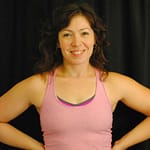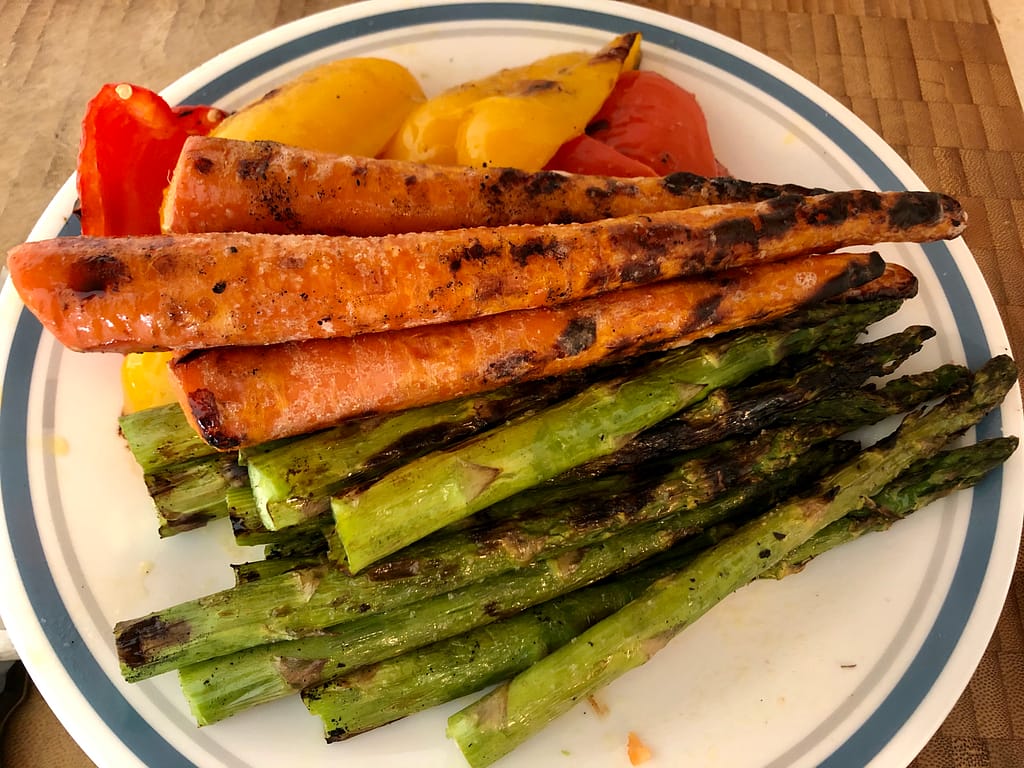- 2 pounds of baby spinach
- 3 pounds zucchini
- 2-3 pounds asparagus
- 2-3 bags of cauliflower rice
- 1 pound of carrots
- 4-5 peppers
- 7 large romaine hearts
- 1.5 pounds mixed tomatoes
That’s what I buy every week in vegetables—for myself. Just for me.
I eat about 2.5 cups of vegetables at 3 of my 5 meals each day. At dinner, I tend to eat a big ass salad, which amounts to 3.5+ cups of veggies. And my veggie list doesn’t include condiments, like sauerkraut or salsa, where I inadvertently get even MORE veggies.
You know that thing where you buy the fresh veggies, never use them, and end up throwing them away, wilted and smelly, a week later?
That doesn’t happen in my house.
The average American gets 1.5 cups of vegetables a day compared to my 10+ cups per day. So when I talk to people who start eating healthy meals for the first time, and they complain that they’re hungry between meals, even after they’ve hit their protein needs, I always know what the culprit is:
Not enough vegetables.
I know what you’re thinking. 10 cups is too much, right? And the USDA only recommends 5-9 servings a day, and they include fruit in that, so don’t we only need like 2.5 cups of veggies a day? Not 10?
Not if you want to THRIVE instead of merely staying ALIVE.
A few years ago, a group of researchers out of London did a meta analysis of 95 studies on fruit and veggies in the diet, trying to figure out what the optimal level of fruit and veggie intake would be to prevent premature deaths from things like heart disease, stroke, cancer, and related underlying conditions.
The answer was 10 servings, or about 800 grams.
Even when they accounted for the impact of things like body weight, activity levels, and smoking habits in their evaluation, the benefits of increased fruit and vegetable intake were still clear. The best options, according to them, are citrus fruits, apples and pears, green leafy things like spinach and lettuces, and cruciferous vegetables like broccoli and cauliflower. Adding additional colors to the mix, like eating yellow vegetables like carrots and peppers, added reduced cancer risks.
I didn’t start eating so many vegetables because I wanted to avoid death, though. I mean, sure, I want to live a long life. But I started eating so many vegetables because I enjoy volume eating—I like a plate that looks like it’s very full, like I am eating a lot, even if it’s actually pretty low calorie. And vegetables, especially greens, give you a TON of eyeball-satisfying volume with very little calorie impact.
I also had some periods in my day where I couldn’t eat a snack or another meal for a good 4-5 hours, and while I don’t mind feeling hungry (in fact, one of my favorite things is waking up early in the morning already hungry for breakfast), I did have to find meals I could rely on to keep myself from being cranky between meals. Vegetables fit the job perfectly. They take longer to digest, they make you feel full, and they thus prevent cranky Kristen from rearing her head at inopportune moments.
So how do you go from a mere 1.5 cups a day to something closer to 10?
Here are some tips:
🥕 Cook your veggies. They will be easier to digest.
🥕 Salt and season them so they taste great.
🥕 Eat the veggies your body can handle. Me + broccoli = 😡. So I avoid it.
🥕 Eat the veggies you enjoy. I hate green beans. So I don’t eat them.
🥕 Combine small servings of several veggies. Ever try to digest 2 cups of broccoli in one meal? It’s awful. Try mixing 1 cup of broccoli with something easier to handle, like carrots, instead.
🥕 Learn the tastiest ways to prepare them. Steaming? Blech. I prefer grilling (pictured) and roasting above all other methods.
🥕 Choose a variety of veggie colors. Greens are great, but get some reds, yellows, and whites in there, too.
🥕 Eat vegetables all day, not just at dinner. Yes, you can eat veggies for breakfast. And yes, you can have something other than baby carrots with ranch dip in your lunch bag.
🥕 Eat some veggies seasonally, when they naturally taste best. Asparagus tastes best in spring and summer. Brussels sprouts are tastiest in fall.
🥕 Use frozen veggies if you like them. I dislike frozen, except cauliflower rice, because I prefer to grill or roast veggies, and frozen doesn’t work as well. But if you like frozen, go with it. They are nutritionally the same as fresh.
🥕 Change your options sometimes. I eat a little of everything on the above list each day. If you rely only on carrots and spinach, you might get sick of both, but you’re also missing out on tons of vitamins, minerals, and antioxidants.
🥕 Look for easy to prep options. Zucchini can be chopped and microwaved in two minutes. Baby spinach needs no chopping and can be put into meals raw.
🥕 Drink more water if you add more veggies. If you don’t want the veggies to make you feel bloated, water is the answer.
🥕 Give your body time to adjust to added veggies. Your body will stop feeling so full after you’ve been consistent with your intake.
I know some people think they can just make up for whatever veggies they skip by popping a vitamin or some other supplements. But most of nutrition is about context—the compounds we get from foods aren’t beneficial all on their own. They work together with the other vitamins and minerals and compounds in our diets to produce a lasting health effect.
In other words, it’s about the whole package. So eat the whole food.
And eat your dang veggies.
About the author

Kristen Perillo
Kristen Perillo is a teacher by day, trainer and nutrition coach by night. She's also a Star Wars nerd, writer, dog (and cat) mom, peanut butter junkie, and Seinfeld devotee. Fitness has done nothing but make her life better, and she is privileged to show other people that it will do the same for them.


Recent Comments